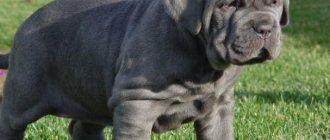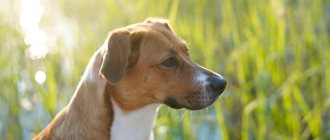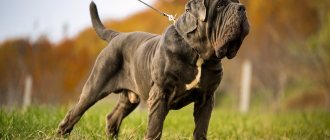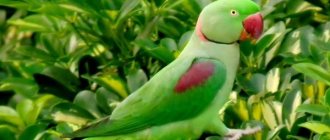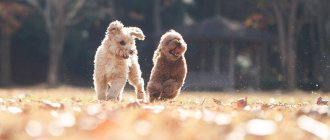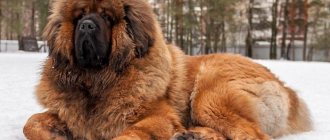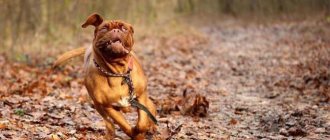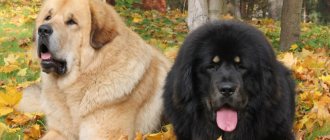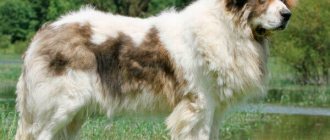The Mastino Neapolitan is a large dog with folds and a slightly sad look. This breed earned the title of protector and guard even under Alexander the Great.
The Neapolitan mastiff became the hero of Homer's songs, the works of Plutarch and Aristotle. Interest in this animal continues today.
The ancestors of the Neapolitan Mastiff are considered to be Molossians, distinguished by their enormous size. Knowing no fear or pity, they were the basis of Xerxes’ army in the 5th century BC. e.
There are 2 versions of the interpretation of the name of the breed. According to the first, the word mastiff comes from the Latin massivius - massive, large. According to the second, from masuetinus - tamed. The oldest images of Neapolitans belong to the Assyrians. They were carved on bas-reliefs next to the warriors.
It is known that there were over 50 dogs of this breed in the army of Alexander the Great. Later, mastiffs were involved in hunting, guarding houses and livestock.
For a long time, no one was engaged in special breeding of massive dogs. The Italian artist Pietro Scanziani, who lived on the outskirts of Rome in the mid-20th century, became interested in them.
He saw a Mastino at a non-competitive dog show, and 3 years later he was the owner of a dog, which served as a model for describing the breed standard. The first version was compiled without taking into account physical and service characteristics, and therefore was supplemented several times. The Mastino standard was finally approved only at the end of the last century.
Description
Neapolitan dogs are among the largest in the world. In size, they are second only to Alabai, Great Danes, Divers and other varieties of mastiffs (English, Spanish, Pyrenean and Tibetan), occupying 12th place in the ranking of the most warlike dogs. A distinctive characteristic of the breed is powerful muscles and wide bones.
The mastiff moves slowly with the grace of a large cat. While running, it pushes with its hind limbs, throwing its front limbs wide forward. But only an extraordinary event or the command of the owner can force the Neapolitan to move quickly.
Nicknames
The following nicknames are most suitable for the Neapolitan Mastiff:
| For boys | For girls |
| Snickers | Shelley |
| Zungru | Lilith |
| Raulik | Lastena |
| Zummo | Zito |
| Pascal | Aza |
| Binagu | Nadusha |
| Hussar | Myra |
| Jacob | Axida |
| Tobias | Donna |
| Kapysh | Joga |
Characteristics
The Mastiff is distinguished by its large size: its weight ranges from 50 to 70 kg, and its height at the withers ranges from 60 to 75 cm. Despite their external clumsiness, these dogs move gracefully and gracefully. The body is powerful, slightly elongated (10% higher than height).
The characteristic large folds were inherited by the dog breed from their fighting ancestors. Strong muscles are visible under the “hanging” skin. The tail is sickle-shaped and can be docked by a third.
The wide cheekbones and high forehead of the Neapolitan Mastiff are covered with folds that extend into the neck. They are brightly outlined and mirror identical.
This dog has strong white teeth with a pincer or scissor bite. The lips are fleshy, slightly parted, with visible mucous membranes.
The eyes are set deep and surrounded by folds, giving the muzzle a sad expression. The ears are fleshy, drooping or cropped. The paws are wide with strong muscles, straight. The hind ones have hock joints.
Accepted Standards
Description of the breed standard:
- The head is large, short, with a lot of skin. It has many folds that hang down to the dewlap.
- The jaws are powerful, with a full set of teeth. Mite-type bite.
- The nose is wide, with open nostrils. Pigmentation depends on color.
- The eyes are round and wide-set. The color is slightly darker than wool.
- The ears are triangular, hanging, thick. Previously, they were subject to cupping due to possible diseases of the middle ear.
- The neck is strong and powerful. Middle length. It also has folds.
- The back is of medium length, but impressive width, with well-developed muscles. Slightly arched lower back.
- The limbs are strong and strong. Proportional to the body. Paws are voluminous, lumpy.
- The coat is smooth and short.
Disqualifying criteria include:
- undershot;
- a muzzle that is too short or a hump on the nose;
- short tail length or its complete absence;
- eversion or inversion of the eyelids, cataract, strabismus, white or colorless iris of the eye;
- aggression and cowardice;
- lack of suspension, folds;
- depigmentation of the nose;
- too large white markings in permitted areas or their presence on the head.
Character and appearance
The mastiff's coat is short and thick throughout the body. In females it is velvety, in males it is hard. Different colors of dogs are allowed:
- blue;
- grey;
- fawn or isabella;
- black;
- brown-yellow;
- mahogany.
Mandatory for show Mastino are Neapolitan - “brown”: stripes of a darker shade than the main color of the coat, located vertically.
Acceptable spots are white or beige on the chest and on the limbs near the toes.
Despite their dangerous appearance, Neapolitan mastiffs are very sensitive and gentle, they immediately respond to all changes in the owner’s mood.
Loyal to their owner, dogs are ready to protect him, even risking their lives. However, they are never the first to engage in battle, nor do they pose a much weaker threat to the enemy.
A negative character trait of Mastino Neapolitan is laziness.
These animals love to lie around and cuddle with their owner. The owner's care is a guarantee of their good mood and well-being. If they are not paid attention to, they become upset and may even lose their appetite. Left unattended, they will howl loudly and misbehave.
Timely socialization is important for the mastiff. If you don't introduce him to other people and animals as a puppy, he will grow up to be cowardly or angry. And proper training will turn him into a loyal, friendly and discreet four-legged friend.
Representatives of the breed jealously guard all family members, so they try to gather them together during walks to make it easier to keep an eye on them. Possessing an innate instinct, they accurately determine the relationship of strangers to the owner. They can shield the owner with their body, hearing a conversation in a raised voice or feeling a threat against him.
Some breeders give the Neapolitan Mastiff puppy the right to choose its owner. Whoever the dog runs to takes it away. This approach allows for the formation of close contact between an animal and a person from the first days of their living together.
History of the breed
The Neapolitan Mastiff is a dog that, since ancient times, has stood guard over its owner and his property. The birthplace of this breed is Italy. It is believed that the appearance of the first Neapolitan Mastino occurred in the south of the Apennine Peninsula.
The ancestors of modern Mastino (Molossian Great Danes) took part in driving wild animals and fought in the arenas of Ancient Rome with their relatives or with predators. In most cases, the battle ended in victory for the Molosser.
This is not to say that the Neapolitan was kept only in the homes of the ancient Roman nobility, although it is worth noting that such pets were a fashionable addition to any rich man. Mastiffs faithfully served ordinary people (watchmen, peasants, shopkeepers). The task of the huge dogs was to protect property and scare away thieves and robbers.
Mastino breeding was not targeted. If the rich at least somehow monitored the purebred of their Molossians, then the common people paid attention only to the working qualities, height, and weight of the guard dogs.
The Second World War virtually exterminated purebred Great Danes. When fascism was defeated, it became possible to restore the numbers of these giants. This is exactly what Pietro Scanziani, a connoisseur of Neapolitans, did in 1946.
He collected 8 representatives of the breed with characteristic exterior features. As a result of breeding work in 1949, an exemplary male was bred, which became an example for establishing the Neapolitan Mastiff breed standard.
Modern Neapolitan Mastinos take part in exhibition shows instead of fighting in arenas. Their strength and intelligence have found application in police and guard service. Mastiffs have proven themselves as bodyguards and security guards.
Education and training
Innate willpower and self-esteem make training Neapolitan dogs challenging. They have high intelligence and good memory, but the owner will require attention and patience. The tone in which commands are given is important. If the owner pronounces them confidently, the dog does everything unquestioningly.
Repeated repetition of the same commands tires the Mastino. These dogs prefer leisurely walks with people. They will remember even the light cotton of a newspaper for a long time and will not repeat the mischief.
Therefore, dog handlers talk not about training, but about raising dogs of this breed. The lack of necessary skills will turn your pet into an uncontrollable mountain of muscles, which will be difficult for even a large man to cope with.
It is forbidden to keep a mastiff on a leash. This negatively affects his character. If the dimensions of your house or apartment do not allow you to accommodate a massive pet, then it is better not to get such an animal.
Where is the best place to keep it?
As noted above, these dogs are not suitable for keeping on a chain or in an enclosure. The ideal place for them to live is at home. There they are close to the person, but at the same time they have enough space and have the opportunity to spend time outside without strangers.
As for the apartment, opinions differ. If the apartment is large and spacious, then it is quite possible. Many owners keep it this way. The main thing is that both you and the dog feel comfortable.
Care and maintenance
Despite its large dimensions, maintaining a Neapolitan does not require any special skills. These dogs have short fur, so it is enough to brush them twice a week with a natural bristle brush.
It is recommended to bathe mastiffs only when absolutely necessary. Frequent water treatments disrupt the production of sebum, causing seborrhea, hair loss, and dermatological diseases.
The ears require special attention if they have not been cropped. They should be cleaned 2 times a week. Teeth and eyes are cleaned daily. In a stressful situation or while waiting for a meal, Neapolitans experience active salivation. The liquid must be removed to prevent maceration of the folds and their inflammation.
To maintain good physical shape, it is recommended to walk with your mastiff at least 2 hours a day. This will allow the pet to communicate with other dogs, stretch its paws, and play. The impressive size and thick coat cause the Neapolitan to overheat. Therefore, in summer it is better to walk with him in the evening or early morning.
Mastiff nutrition
The ideal solution is high-quality dry food. It makes keeping a large dog easier. You don’t have to additionally select multivitamin complexes and calculate kilocalories in your diet. In addition, mastiffs are not known for being careful when eating, and it is much easier to collect dry pellets from the floor and face.
The frequency of food intake and its volume depends on the age of the Neapolitan. Adults eat once a day. When feeding natural products, half the menu should consist of meat by-products. Additionally, bread, cereals, vegetable (sunflower or olive) oil are shown as a source of quickly digestible carbohydrates and fats.
It is not recommended to feed Neapolitan Mastiffs chicken, bones and rice. Such dogs additionally require calcium supplements to prevent diseases of the skeletal system, as well as vitamins for teeth and coat in spring and autumn.
Large Breeds Puppy Large Eukanuba Dog food has been developed for Neapolitan babies. Their high content of calcium and phosphorus helps strengthen bone tissue and form a proper skeleton, and activates the growth of puppies. Special dry granules produced for large and giant breeds, such as Mastino, prevent obesity and have a positive effect on the nervous system.
Diseases of Mastino Napoletano
The modern Neapolitan Mastiff is a godsend for the veterinarian. All Molossians, due to their loose, heavy structure, are prone to many diseases, but the gigantic Mastino is especially so. Unfortunately, he does not live very long - on average nine years, and the breed’s “bouquet of ill health” consists of the following problems:
- dysplasia;
- cardiomyopathy;
- allergies;
- retinal atrophy;
- dermatological diseases;
- obesity.
Mastinos do not live long, and improper maintenance is fraught with many diseases for them.
Hip and elbow dysplasia is one of the most common diseases in all Molossians. The predisposition to it is largely due to heredity, but up to a third of cases of pathology arises due to poor quality raising of a large and heavy dog: improper feeding and injuries. Until the age of one, you need to be very careful with the puppy’s paws, do not allow him to jump and walk on a slippery floor; distribute physical activity wisely. From five months onwards, the dog’s diet should contain special supplements for the development and strengthening of joints.
At the same age, the first x-ray examination should be done, especially if the puppy begins to limp after sleep, pull its paws, or experience discomfort or pain. The sooner you start treating dysplasia, the better results you will get. Surgical intervention for this disease is resorted to only in extreme cases, when the situation is advanced and drug therapy is no longer effective.
Health and treatment
Mastiffs are distinguished by their excellent health. The peak incidence occurs exclusively in puppyhood (up to 1 year). Neapolitan babies can become infected with a viral or bacterial infection, so up to 3 months they are required to be vaccinated against diseases such as:
- hepatitis;
- parvoriosis;
- plague;
- leptospirosis.
In the first year of life, the dog should receive a rabies vaccination, which is repeated every 12 months throughout its life. The ideal time for vaccination is spring and late autumn.
Before the procedure, the mastiff is treated for fleas and worms.
In addition to respiratory infections, this breed of dog is susceptible to the following diseases:
- filariasis (cardiac or pulmonary), carried by blood-sucking insects;
- intestinal volvulus, mastiffs suffer from it after reaching 5 years of age.
Regular treatment of the dog for parasites, mandatory half-hour rest after eating, daily active games and walks in the fresh air will help prevent dangerous pathologies.
Rules for choosing puppies
The Neapolitan is a dog that requires a responsible approach to its maintenance. Therefore, in order to avoid purchasing a sick and non-viable mastiff puppy, it is better to purchase from a nursery with a good reputation.
It is imperative to require the pedigree of the dog you are purchasing so as not to become the owner of an uncontrollable aggressive Neapolitan.
During the meeting, the future owner can independently test the children for psychological stability. To do this, it is enough to pay attention to how the young animals react to a sharp sound and the presence of strangers.
The right puppy is curious at first, and once he is convinced that he is not in danger, he is ready to play. If he tries to hide, run away or bite, this is a sign of a mental disorder.
A healthy dog is moderately well-fed, active, sleeps peacefully, has clean ears, nose and eyes, smooth fur without bald spots. If at least one of the listed qualities does not correspond to the norm, it is better to refrain from purchasing such an individual. You need to check with the breeder what vaccinations have been carried out, and also ask for a meeting with the puppy’s parents.
A nursery that values its reputation will be sure to complete all the necessary documents, including:
- puppy card;
- veterinary passport;
- pedigree.
In the future, the new owner has the right to seek advice from the breeder or club specialists to resolve emerging issues regarding the care of the small mastiff.
Mating
If the dog’s development proceeds normally, then the first estrus in mastiff females occurs at the age of 0.5-1 year. Delayed or premature estrus indicates some kind of developmental pathology. You should consult a specialist for advice. The first heat is not a reason to breed a dog, because, in fact, it is not yet strong enough. It is best to wait until 2-3 heats to make sure that everything is fine with the animal.
When the dog begins to heat, which indicates readiness for mating, you can invite a male. To do this, you should agree in advance with the dog’s owner and set a day suitable for both parties. It is advisable to let dogs go after a long walk. To avoid any unpleasant or unforeseen moments, it is best to invite an instructor to the first mating, who will monitor the process and help in case of failure.
Puppy cost
The price of a Neapolitan puppy is based on the following nuances:
- Availability of pedigree. This doubles the cost of the dog.
- Victories of the baby's parents at exhibitions.
- Color. Black individuals are the cheapest, while fawn, yellow and blue ones will cost more.
A mastiff without a pedigree will remain only a pet; it will not be able to participate in exhibitions or breeding.
On average, you can buy a small Neapolitan in Russia for 25 thousand rubles.
Price
Those who want to become the owner of an elite dog should not rush to choose one. We recommend visiting a few dog shows and talking to breeders before making a purchase. After you have received some valuable advice from the professionals, you can head to one of the nurseries.
This is the best place to buy a dog. The nursery regularly monitors the health, nutrition and behavior of each puppy. The price of a Neapolitan mastiff in such an institution is from 40 to 90 thousand rubles. The cost of an animal is influenced by several factors: its age, health, the presence of parents with a title, as well as color and exterior features.
You can also make a similar purchase from private breeders. This will save you several tens of thousands of rubles, but keep in mind that the breeder cannot guarantee you the excellent health of the puppy.
Interesting facts from the life of dogs
Mastiff is one of the oldest breeds. And much in the history of the origin of this dog still remains a mystery. Even the decoding of the name has several options. One thing is certain. These animals are impeccable warriors who are devoted to their owner, no matter what happens.
The skeleton of small Mastinos is more fragile than that of Toy Terrier puppies. This is due to their build. If in decorative dogs the weight increases by 20 times from birth to adulthood, then in Neapolitan mastiffs it increases by 70. Therefore, the dog’s skeletal system takes much more time to get stronger.
In 2004, a representative of the breed became a Guinness Book record holder for its unique weight of 128 kg. The name of the huge dog is Hercules. In 2004, this dog was considered the heaviest in the world. Every day she needed 1.5 kg of prepared food and a kilogram of raw meat. What’s surprising is that Hercules’s body weight exceeds the average weight of a Neapolitan dog by 2 times.
The largest representative
Hercules is the largest and most famous representative of the breed.
In 2001, he was included in the Guinness Book of Records as the largest dog. By the age of 4, his weight reached 128 kg, and his neck circumference was almost a meter. This was twice the standard parameters of the breed.
His owner, the Englishman Mr. Flynn, says that the dog is like that by nature. He was not fed any special vitamins or supplements. He was the largest puppy of the litter and developed and grew quickly.
Mr. Flynn was given the idea for a record bid by a neighbor boy. After Hercules got into the book, journalists and reporters do not leave him and his owner alone.
Reviews
Katya, Novosibirsk: the mastiff’s terrifying appearance is deceptive. This is the most good-natured, loyal companion. The main thing is to raise the dog correctly, and it will be able to play safely even with small children. Tested on myself and my sons. The whole family loves our Lelya.
Irina, Novgorod: many people mistakenly consider Neapolitans to be aggressive fighting dogs. It is a myth. If a dog is specifically trained to attack, it will do so. But when a puppy has grown up in love, he is kind and friendly.
Nikolay, St. Petersburg: I met a guy who had an adult mastiff. At first the dog seemed like a lazy lump to me. But Joni turned out to be a cheerful and active animal who loves to go on walks with us. It’s not scary to walk with such a guard even at night.
A good-natured disposition will make a Neapolitan your most loyal friend, and his intimidating appearance and innate intuition will protect him from ill-wishers.
The dog chooses its owner once and for the rest of its life, rejoicing like a puppy when he returns home. Mastiffs are suitable for those who like to walk outdoors every day and are ready to pay attention to their pet.
Application
The Neapolitan Mastino will zealously defend its owners and its territory. He can drive away unwanted guests with just his fierce look.
If you want to get yourself a guard dog for a private home, we recommend that you familiarize yourself with the following list:
This is a strong and intelligent dog, which is most often used as a guard, similar to the Turkmen Alabai .
Clumsy Neapolitans

